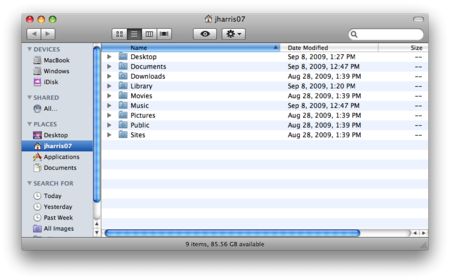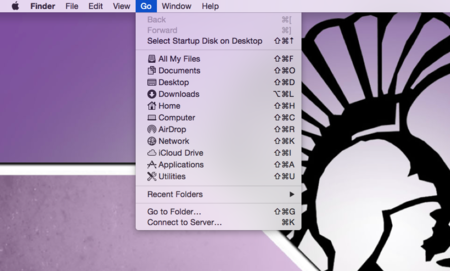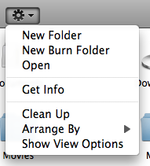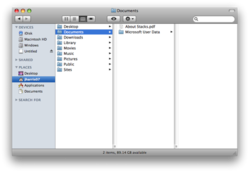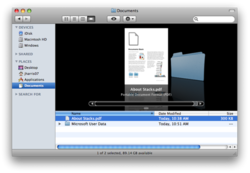Where on your Mac laptop are your files
About this article
This article defines the default file folder locations of all WSU-supported Mac laptops. It is intended for both students and employees who participate in the eWarrior Digital Life and Learning Program. It is important for everyone to know where their files are at all times, especially when preparing for a laptop exchange or re-image.
Where are your files?
You have full administrative rights to your laptop. That means you have the ability to save your files just about anywhere on your laptop's hard drive. You may have saved things, intentionally or unintentionally, to locations other than the ones described in this article. It's up to you to find and manage those folders and files. ITS configures every MacBook hard drive the same way:
- All MacBooks have an icon on the Desktop that provides access to the hard drive. The icon is labeled with the model of your MacBook and the year you received it (Fig 1). Double-click this icon to open your hard drive.
- When you open your hard drive, you will see a list of subfolders, including Applications, Library, System, and Users. Do not touch the first three folders. These store important operating system and application files.
- Your Users folder includes your Home directory. It has an icon that looks like a house and it's labeled with your StarID. The appearance of the icon differs slightly depending on the operating system you are using (Fig 2).
About the Home folder
Your Home folder is a special folder on your hard drive set up just for you. This is where you should save any personal or school-related files on your laptop. To help you keep your files organized, WSU created some sub-folders in your Home folder (e.g., Documents, Music, Pictures). You can use these folders if you wish or you can create your own. You can also create sub-folders within these folders (e.g., a Courses folder inside your Documents folder). Build a folder structure that works for you.
How do I access the Home folder?
From the hard drive icon
- Double-click the hard drive icon
- Double-click the Users subfolder
- Double-click the icon that looks like a house labeled with your StarID
From Finder
- Select the Go menu
- Select Home
About the subfolders in your Home folder
Documents, Music, Pictures, Movies
These are folders that we created for you thinking that this might be a nice way for you to organize your files. If this works for you, great. If you want to create new folders with new names, that's fine too. However, keep in mind that these folders are default save locations for various applications. Even if you don't want to use them, please don't delete them for awhile until you are sure you have your own folder structure and default save locations worked out.
Downloads
This folder contains any application update, printer driver, or other software or hardware-related file you ever downloaded from the web. The vast majority of these files do not need to be retained because you will probably never use them again. However, this folder may also contain manuals, journal articles, image files, and other useful, downloaded documents or media that you do want to retain. Take a look through your Downloads folder regularly. Delete anything you don't need and move anything important to another folder to better organize it. Ideally, your Downloads folder should be empty.
Desktop
The Desktop folder in your Home directory contains all the folders, files, and shortcuts found out on your desktop. Some people like to store things, lots of things, right on their desktop. They save files, folders, and shortcuts to applications right out on the desktop. If this method works for you and you want to replicate it on another MacBook following a re-image, back up the Desktop folder and then copy and paste it to your Home directory on the new or re-imaged machine. Note that your shortcuts will not work on the new or re-imaged laptop if the applications they link to are not in the same place. The fastest way to restore them is to delete them and recreate them on the new laptop.
Applications
Some applications that you install on your laptop will set up folders in this Applications directory that serve as the default save location for files that you create using the application. Check the Applications folder before you exchange or re-image your laptop and back up any project files you find. Note that this folder is not where the actual applications are housed.
Public
Because Apple OS X is a multi-user operating system, the Public folder is there to allow you to store files that would be accessible to other people who log on to your MacBook. Because no one but you typically logs on to your laptop, this folder isn't very useful. Don't delete it just in case you might need it someday.
Other sub-folders
There may be other sub-folders in your Home folder. Some applications that you install on your laptop will create sub-folders in your Home folder to store personal data and files associated with that application. The actual application itself is stored in another location. For most applications, you can change their default save locations if you wish, but always check any sub-folders in your Home folder to see if there is anything in there you want to back up and retain.
What's a default save location?
Some applications have default save locations for files you create using that application. For example, Microsoft Word opens a specific folder in your Home directory the first time you Save a document and every time you select Save As. WSU has already set the default save location of many of the applications that came installed on your EliteBook. For example, the default save location for Word is your Documents folder in your Home directory. When you install applications, a default save location is selected automatically or you are asked to select one during the installation process. You want the default save location to be a folder in your Home directory. For example, when you install Apple iTunes, it will use your Music folder in your Home directory. Sometimes, an application will pick a very strange and out of the way default save location. Keep your eyes on this as you install applications and change the default save location if needed. Also, be careful about deleting or renaming existing folders in your Home directory if they are default save locations for an application. The files you will want to backup are shown in BOLD in the list above. You will not need to backup anything else.
NOTE: You can position the two Finder Windows to be side by side for dragging, but only one Finder Window can be active or in-front at a time.
Finder and File organization
You can use your Finder to view/find the files that you have stored on your computer, on attached devices (such as portable hard drives or flash drives, and in network storage. The Home Directory is where your files are automatically stored.
Your Home Directory consists of eight folders that are referred to as the “root” folder for that “directory.” These root folders include Desktop, Documents, Library, Movies, Music, Pictures, Public, and Sites.
The Desktop folder includes all of the files on the desktop which you see when you start up your Mac and which appears to be underneath this Finder Window. When backing up your important files, you will need to make sure that you back up this “Desktop” folder. See more about backing up below.
The Documents folder is where Microsoft Office applications save your Word, Excel, and PowerPoint files by default. Your iTunes Music go into the Music folder and iPhoto pictures go into the Pictures folder. When you download something, it will automatically be placed inside your Downloads folder.
By clicking the drop down “Cog” button you will have clickable access to creating a New Folder, opening the file, Get Info, and other options for this file or this place in the directory.
Get Info is the used when you would like to modify important attributes of the file. This function can be used to change the name of the file, the file extension, the color label, the icon and security and sharing settings. At the top of every finder window you will find a red, yellow, and a green button. The red button closes the open window. The yellow button reduces the window to your dock. The green button enlarges the size of the window. Below the three buttons you will find a right and left navigation button.
The three buttons to the right of the navigation button control the way that you VIEW your files in the window. You can view them as icons, as a list, in columns of folders and contents, and in Cover Flow.
This View is good for seeing how documents are stored inside the hierarchy of folders on your computer.
It will show you what the actual document selected looks like. If you press your space bar, it will open that item into a full preview.
Creating a Directory or File Organization
Many students create new folders in their Home Directory or inside Documents or other folders to keep class files and personal files organized.
By using a rigid file organization structure you can more easily back-up data.
It will also make it easier to locate and use files for your senior portfolio project.
An example of such a file structure is shown here.
